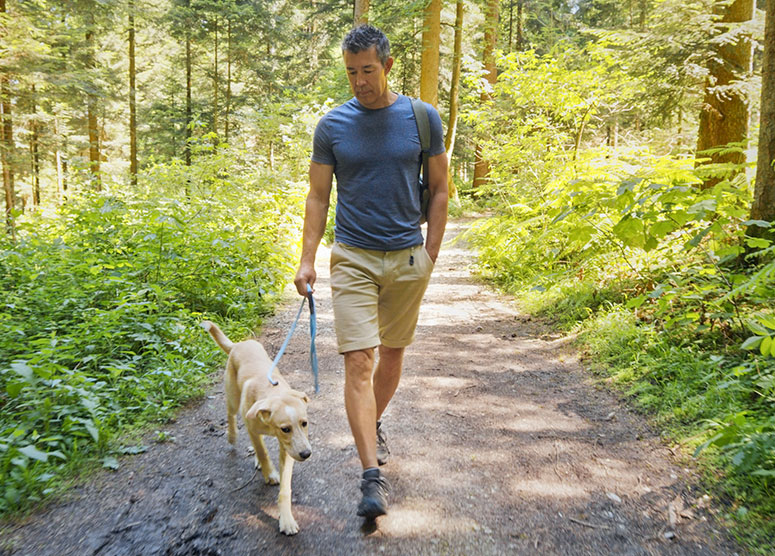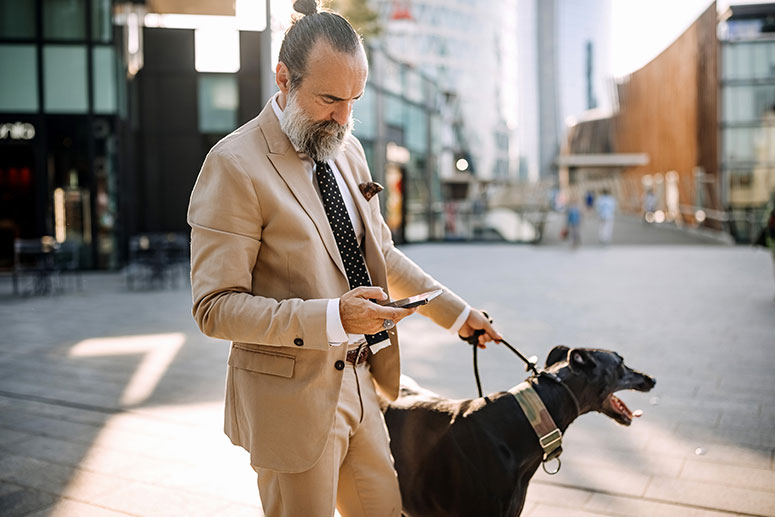Key Takeaways
- When walking your dog, pay attention to them and avoid distractions such as mobile phones, earbuds, carrying items, and anything else that could divert your attention.
- Distracted dog walking causes many accidents and injuries for both the human and their furry companion.
- Use the time walking your dog to improve your bond with them, teach new skills and provide consistency and attention.
Many people try to combine this activity with other tasks, typically using their phone to read, look at social media, text, or talk. Others use earbuds to listen to music or podcasts, blocking out ambient noise. Other distractions include walking with groceries or other items in your hands, pushing a stroller, walking with a small child, or drinking or eating.
While it may be tempting to try to combine tasks, dog walking requires your full attention and focus. Trying to juggle other activities could endanger you and your dog. Consistency is important to dogs, and if you are not watching them, the walk will be more erratic and confusing to them.
Also, recent research suggests that few people can multitask effectively and that trying to do so will result in less productivity and poor results. Look at dog walking as quality time with your pet and a perfect opportunity to strengthen your bond and work on training behaviors you want to improve.
Chance of injuries – for you and your dog
You are putting both yourself and your dog at risk of injury if you are not paying attention. One study looked at dog-walking-related injuries from 2001-2020 and found that the number of injuries treated in emergency rooms increased by fourfold during that time. Distracted dog walkers are more likely to be injured by tripping over a curb (or their own dog), getting tangled in the leash, or not anticipating a squirrel or other enticement that could cause a dog to lunge.
The most common dog-walking injuries were in the upper extremities, and the three most common were finger fracture (6.9%), traumatic brain injury (5.6%), and shoulder sprain or strain (5.1%), according to researchers at Johns Hopkins University. Falling when pulled or tripped by the leash was the most common cause of injury.
Dogs with distracted walkers also become injured or sick when they eat garbage, such as chicken bones or dead animals, get into fights with other dogs, or take off when you don’t have a strong hold on the leash.
One of the biggest risks of not being attuned to your walk is traffic, especially if you live in a city and take walks in an urban environment. Even if you have your dog on a leash, they could easily pull into a busy street. Other pedestrians and bicyclists pose another hazard. If you are looking down at your phone, you could plow into an unsuspecting pedestrian or cyclist. With faster-moving bicycles, in particular, the leash can stretch in front of the cyclist, or your dog may run in the bicycle’s path.
If you have a dog who is leash-reactive, meaning they react to triggers on-leash (other dogs, humans, bikes, etc.), or are fearful, you will want to avoid walking them in crowded or urban environments, said Danette Johnston, a Seattle-based trainer and owner of Dog’s Day Out daycare. Leash-reactive or anxious dogs need to be trained away from stressful situations to make progress. If possible, try to take these dogs to an area where they are unlikely to encounter people or other dogs for exercise and training.
“We need to ‘work’ the dog when they are under threshold (the sympathetic nervous system is not firing off), so some people, particularly those who live in a busy urban space, will want to stop walking their dog in that environment while they work on training,” she said. “This may include changing their conditioned emotional response (CER) to their triggers as well as learning cues and techniques to exit a situation before reacting.”
Johnston said while they are training, those anxious and leash-reactive dogs still need to be provided with enrichment and exercise with activities such as games, tricks, and nose work.

Harming your bond with your dog
Remember that your dog’s daily walk is probably the highlight of their day. They experience much of their world through their nose, and if they are not allowed to sniff, they can become frustrated. You want to observe and allow them to investigate an especially interesting bush or spot. They also need to stop to pee and poop. If you are just marching forward and looking at your phone, the walk will be more erratic and confusing for your dog, and you could fail to notice if they are hurt or anxious.
Dogs who are bonded to their people tend to look at them frequently for reassurance and direction. So, your dog will notice you aren’t focusing on them. Dogs communicate primarily through non-verbal body language. If you aren’t paying attention to what they are “saying,” you won’t know how they feel.
“Having a connection with your dog is a prerequisite for them to respond to any cues you give them. Building engagement with your dog so you are walking together is the key. It’s not your walk or his walk, it is OUR walk,” Johnston said. “The first thing I want to do is reward my dog for any engagement with me; when he looks at me or orients towards me, he gets a treat. This opportunity is lost if you aren’t paying attention to your dog.”
Conclusion
To ensure a safe and enjoyable walk, put away your phone, avoid wearing headphones, and keep your hands free. By doing so, you’ll not only keep yourself and your dog safe, but you’ll also have a stronger bond and be able to fully enjoy the experience of walking your furry companion.


